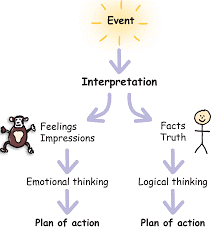Global View Investment Blog
5 Ways Investors Sabotage Themselves
Most investors don’t act in their best interest, even when advised to do so. I was surprised by this 20 years ago. Now I know what to do. My job is not just to translate the mumbo-jumbo financial services firms tell investors. It’s also to help them get the best outcome they can, based on who they are.
Finally, after almost 20 years of doing this, I’ve figured it out: My job is to help clients manage their chimps. I know what you are thinking: That’s an insult; I don’t have a chimp! OK, but I probably got your attention.
You see, investors take risks because they don’t know what risk they are taking. Maybe you’ll take that seriously. Because a Nobel prize winning economist wrote that one. Daniel Kahneman, who has about 30 years of study, found that not only are investors irrational, but that they’re nearly, perfectly, predictably irrational.
But why?
Because they don’t let their humans make decisions. They let their chimps.
Let me explain.
Work by the sports psychologist responsible for the winningest record in Pro Cycling, Team Sky, came to my attention for producing results. Dr. Steve Peters is a neuroscientist with a deep understanding of how the human brain works; rather how the brain works using neuroscience. He uses an easily understandable model even I can get. He describes the conflict between your emotional self and your rational self as a conflict between your chimp and human. And you have a computer that acts reflexively based on decisions you made in the past to your interpretations (and reactions) to events that took place.

I recently wrote this blog about “chimp management” that I encourage you to read: ‘Chimp Management’ – It’s Not Just for Cyclists; It’s For Investors Too.
Daniel Kahneman won the Nobel Prize in economics for this phrase: People take risks because they don’t know what risks they are taking. I like to say it differently. People take too much risk because they let their chimps make decisions instead of their humans.
Let me clarify.
Because nearly every short-term decision we make is made based on emotions, we let the emotional center guide us into action. Daniel Kahneman calls that “System 1.” Steve Peters calls that the chimp. Because I like simpler things, I prefer the chimp.
Now I know why people make poor life choices and terrible investors. It’s because they let their chimp make decisions for them. It’s the reason nearly every investor we test understands that if they invest on their own, they fail. The chimp does not play games to win in the long term.
Thankfully, in the last 20 years, we at Global View have learned how we can help investors manage their chimps. This allows their humans to reap the benefits of a long-term investment strategy.
We do this by educating their humans on what to expect and by helping them exercise their chimps so they can manage them.
For example, nearly every investor we test for risk tolerance wants higher returns than is warranted by his or her ability to weather risk. They want more gain with less pain. Even if our work helps us deliver less pain for gain (a goal), we know investors will still endure a lot of pain. This means we need to educate our clients’ humans on what they will expect to gain over a reasonable time period and exercise their chimps on what they can expect to lose over shorter time periods.
Let’s take a look at the 5 most common ways investors let their chimps destroy wealth (and how to put your human back in charge).
1. Taking Too Much Risk (Chimp Chases Performance)
The No. 1 reason investors make fatal errors, resulting in losing money that is not made back, is they take too much risk.
By gaining a truly valid assessment of your tolerance for risk, we gain an understanding of your expected upside and downside over the short-term. Then we can put this into numerical dollar terms, so your chimp can feel what it will be to see your account down or up. Specifically, we teach you, that if you are a moderate investor, you (and your chimp) must understand that it is very normal for your account to be down nearly 10 percent over six months (at 95 percent confidence). This is normal and expected. And your chimp needs to imagine seeing a statement where $1 million turned into $900,000 on paper. Because I can guarantee you this may happen! It is also normal and expected to be up nearly 18 percent over any given six months, which means you could be up to $1.2 million. And because we don’t have a crystal ball, our humans can’t know which one it’ll be. And our chimps need to exercise to know it could be either one. Because a well-exercised chimp can be managed, when it matters.
2. Letting Your Chimp Buy Something that’s not Real
The second reason investors make fatal errors is because “advisors” have interests other than the clients’ best interest. Sure, you know the big banks have had scandals from doing things in their own best interest instead of their clients. But even discount brokerage firms do this: The advisors in these firms are paid bonuses to push investors into products or take free services intended to get them to actively trade.
We advise our clients (humans) on the myriad of conflicts of interest investors face: Commissions, revenue sharing (pay to play) and “guarantees” that appeal to their chimps.
A great example is the variable annuity with a living benefit guarantee. We show our clients’ humans the cost of the benefit (often 4 percent per year) and how this will eat away at the benefit they leave to heirs. This makes their chimps angry. Because even their chimps don’t want to transfer their wealth from their grandchildren (or other causes) to insurance companies!
3. Avoiding (Rationally Expected) Future Pain
When everything is going well and the chimp is happy, the chimp doesn’t like change. He’s like a frog in water, which might not notice a change until it gets hot. But unlike the mythical frog that stays in the water, the chimp will jump out. Exactly – the chimp will jump out of the market at exactly the wrong time!
It’s why we help investors make the transition to retirement. Because retirement is a period when most investors need to switch strategies from accumulating wealth to withdrawing it. And while it doesn’t necessarily mean they need to take less risk, it often does. Because most investors are unaware of how much risk they are taking! They (humans and chimps) enjoyed seeing their wealth go up. But their wealth went up not only due to high performance (and a long bull market) but also because of aggressive savings and employer contributions. After we educate clients on the downside, and put that in terms of actual dollars, they understand reward only comes with risk and usually decide to reduce risk.
4. Letting Your Chimp Convince You That You Are a Great Investor
One of the problems with us, as people, is that we remember our successes and forget our failures. Especially after a long bull market in stocks and when you witnessed your 401k climb to heights you never imagined!
You must be an investment genius (and maybe you are). But that’s not what the facts tell us. Nearly every investor we test misses at least one of the two key tests we give to test investor fitness. Because we are all (especially our chimps) more averse to losses than we are willing to take risk for gains, we predictably make the wrong decisions.
5. Letting Your Chimp Convince You That You Can Do Everything Yourself
Is this the first time you had to make a key decision?
- Do I have enough money to retire?
- When should I take Social Security?
- How can I pay for health insurance in retirement?
- How should I structure wills and trusts to minimize worry on my spouse, children and other heirs?
Having been doing this for more than 20 years, the global investment advisors here at Global View have seen about everything. When a client comes to us to ask when they should take Social Security, for example, we know a few of the issues that need to be considered. Like all-important life choices, its not black or white. We know most of our successful clients start out unsure about how much income they will need and worried they may run out of money. As they settle into retirement, they usually find they have more than they need. They discover they will leave most of their wealth to heirs: Children, grandchildren and charitable causes. We’re there to help them decide how to best do that, when they are ready.
I, Joey, Adam and Kurt, with the support of Christie, Amanda, Erin and now our newest team member Elizabeth, have been looking at these problems for nearly 20 years. You can feel much more comfortable that the Is are dotted and the Ts are crossed when you have a full-service institutional team looking at the issues for you; a fee-only fiduciary team whose first obligation is to put your needs first. Not our own.
That’s why we have several repeatable systems in place to manage the chimp and put the human in charge:
- We know our clients’ tolerance for risk, and we coach them on how much to expect their portfolios will fluctuate in the short term.
- We teach our clients about the myriad of conflicts of interest banks, brokerage firms and insurance agents face when providing “investment advice,” especially since the DOL Fiduciary Rule was essentially killed due to lobbyist pressure.
- We show them exactly how much losses they should expect in the short-term so they can reap the rewards over the long term. We make them understand this: Human and
- For investors convinced they can do it on their own, we administer a test. We show them how others responded and help them understand it’s normal. Human beings simply aren’t wired to be good investors. Only their chimps think they are.
- The easiest thing for your human to understand is that there is a lot we can do, now and later, to help you, your spouse and your family maximize the wealth they have for income in retirement and later use for heirs.
If you want to do these things on your own, you can find a psychometric risk assessment, learn more about expected upside and downside volatility, educate yourself on the effect of downside risk when withdrawing funds (instead of buying unnecessary insurance) and read up on behavioral psychology (read Kahneman’s “Thinking Fast and Slow” and Steve Peters’ “The Chimp Paradox”). Of course, you will have to also research when to take Social Security and make decisions on estate planning together with an attorney (who may be motivated to sell you more planning than you need).
Or, you can contact us.

Written by Ken Moore
Ken’s focus is on investment strategy, research and analysis as well as financial planning strategy. Ken plays the lead role of our team identifying investments that fit the philosophy of the Global View approach. He is a strict adherent to Margin of Safety investment principles and has a strong belief in the power of business cycles. On a personal note, Ken was born in 1964 in Lexington Virginia, has been married since 1991. Immediately before locating to Greenville in 1997, Ken lived in New York City.
Are you on track for the future you want?
Schedule a free, no-strings-attached portfolio review today.
Talk With Us






